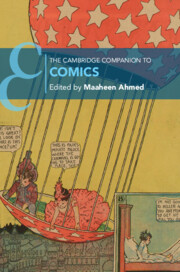Book contents
- The Cambridge Companion to Comics
- The Cambridge Companion to Comics
- Copyright page
- Contents
- Figures
- Contributors
- Acknowledgments
- Chronology
- Introduction
- Part I Forms
- Part II Readings
- Chapter 6 Comics and Multimodal Storytelling
- Chapter 7 Comics Adaptations
- Chapter 8 Comics Genres
- Chapter 9 Life Writing in Comics
- Chapter 10 Racialines
- Chapter 11 Women and Comics
- Chapter 12 Comics at the Limits of Narration
- Part III Uses
- Further Reading
- Index
- Cambridge Companions To …
- References
Chapter 6 - Comics and Multimodal Storytelling
from Part II - Readings
Published online by Cambridge University Press: 17 August 2023
- The Cambridge Companion to Comics
- The Cambridge Companion to Comics
- Copyright page
- Contents
- Figures
- Contributors
- Acknowledgments
- Chronology
- Introduction
- Part I Forms
- Part II Readings
- Chapter 6 Comics and Multimodal Storytelling
- Chapter 7 Comics Adaptations
- Chapter 8 Comics Genres
- Chapter 9 Life Writing in Comics
- Chapter 10 Racialines
- Chapter 11 Women and Comics
- Chapter 12 Comics at the Limits of Narration
- Part III Uses
- Further Reading
- Index
- Cambridge Companions To …
- References
Summary
Comics inherently encompass multiple modalities and are published across numerous platforms, whether in print or digital form. In its distinct combinations of words and images, the multimodal medium of comics has encompassed numerous formats throughout its long history – typically appearing in numerous forms simultaneously in any given era. Comics exist in single-panel and multi-panel strips within newspapers and magazines, in single-issue comic books and longer graphic novel formats and in new digital forms such as webcomics and motion comics. Comics have also been adapted to cinema and television, in both live-action and animated incarnations – often drawing on the original words and imagery of their source material in direct ways. This essay traces the history of comics as a multimodal experience from the 1800s through the twenty-first century; it also examines how other media have translated them onto various types of screens while still drawing on the specific formal qualities used by comics to tell stories. Regardless of the particular format through which readers engage with the medium, comics offer amalgamations of two separate modes of content which allow for unique meanings via the unification of words and images.
Keywords
- Type
- Chapter
- Information
- The Cambridge Companion to Comics , pp. 125 - 142Publisher: Cambridge University PressPrint publication year: 2023
References
Primary Sources
Secondary Sources
- 1
- Cited by

